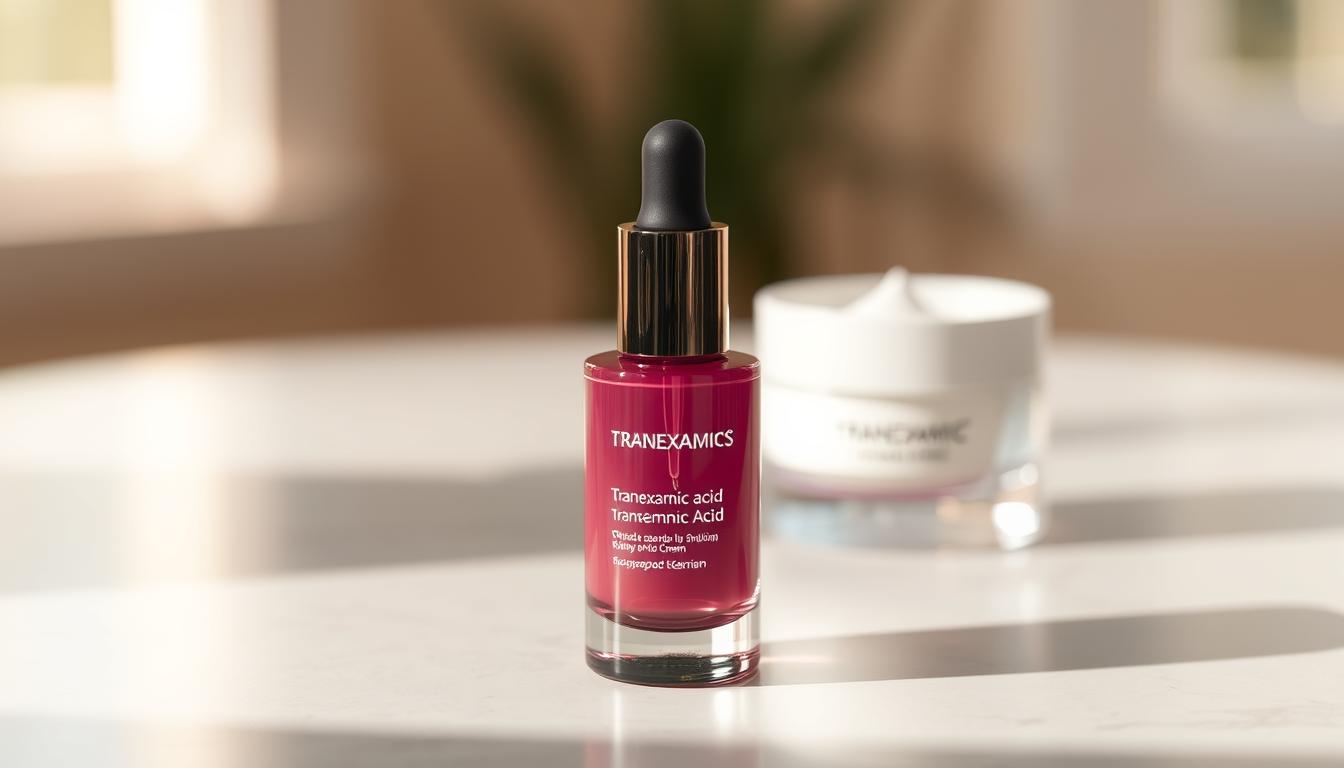Did you know that tranexamic acid has been shown to reduce hyperpigmentation by up to 78.6% in just 8 weeks? This powerful ingredient, originally used to control bleeding, is now making waves in skincare for its ability to tackle dark spots and melasma effectively1.
Unlike hydroquinone, which has been linked to side effects like ochronosis, tranexamic acid offers a safer alternative. Dermatologists, including Dr. Y. Claire Chang, praise its safety for all skin types, even during pregnancy2. Its ability to prevent melanin formation and soothe inflammation makes it a standout in treating discoloration.
In this article, you’ll discover how this ingredient works, its benefits, and how to incorporate it into your skincare routine. Whether you’re dealing with melasma or post-inflammatory hyperpigmentation, tranexamic acid could be the solution you’ve been searching for.
Key Takeaways
- Tranexamic acid is a safe and effective treatment for hyperpigmentation and melasma.
- It originated as a medical treatment for reducing bleeding and has been adapted for skincare.
- Compared to hydroquinone, it has fewer side effects and is suitable for all skin types.
- Clinical studies show significant improvement in skin tone and reduction of dark spots.
- It can be safely used during pregnancy and combined with other skincare ingredients.
Understanding Tranexamic Acid: From Medical Use to Skincare Hero
From hospitals to skincare shelves, tranexamic acid has made a remarkable journey. Originally developed as a synthetic derivative of lysine, this ingredient was first used to control excessive bleeding in medical settings like surgeries and heavy menstrual cycles3.
Its ability to stabilize blood clots made it a go-to treatment for trauma and postpartum bleeding. Dermatologists, including Dr. Y. Claire Chang, note its protein-building amino acid origins, which lend it scientific credibility3.
Medical Origins and Traditional Uses
In its early days, tranexamic acid was primarily used to manage bleeding in high-risk medical scenarios. Its effectiveness in reducing blood loss during surgeries and treating conditions like hemophilia made it a trusted medical agent3.
Over time, researchers discovered its potential beyond bleeding control. Its anti-inflammatory properties and ability to stabilize proteins hinted at broader applications, paving the way for its use in skincare3.
Transition to a Skincare Favorite
Dermatologists soon realized that tranexamic acid could also address skin concerns like melasma and hyperpigmentation. Clinical studies showed its ability to inhibit melanin production, making it a powerful tool for evening skin tone4.
Its medical origins ensure a high level of safety, even for sensitive skin types. This reliability, combined with its brightening effects, has made it a standout ingredient in modern skincare formulations3.
As we explore its chemical properties and benefits in later sections, you’ll see why this ingredient has become a skincare superhero.
How Tranexamic Acid Works on Hyperpigmentation
Tranexamic acid’s ability to target hyperpigmentation has made it a game-changer in skincare. This ingredient works by addressing the root causes of discoloration, offering a dual-action approach to brighter, more even skin.

Inhibition of Melanin Production
One of the primary ways tranexamic acid works is by blocking melanin production. It disrupts the interaction between keratinocytes (skin cells) and melanocytes (pigment-producing cells), reducing the formation of dark spots5.
This mechanism is particularly effective against UV-induced pigmentation. Studies show it decreases melanin synthesis, helping to lighten melasma and other forms of hyperpigmentation6.
Anti-inflammatory and Skin Tone Evening Effects
Beyond inhibiting melanin, tranexamic acid also has anti-inflammatory properties. It soothes the skin, reducing redness and irritation that can exacerbate discoloration7.
This dual functionality makes it highly effective for evening out skin tone. Clinical trials have shown significant improvements in melasma and post-inflammatory hyperpigmentation within 4 to 12 weeks of consistent use5.
Its safety profile further enhances its appeal. Unlike traditional treatments like hydroquinone, it poses fewer risks of side effects, making it suitable for most skin types6.
Beyond Hydroquinone: Why Tranexamic Acid is the New Star in Dark Spot Treatment
When it comes to treating hyperpigmentation, safety is a top priority for both dermatologists and users. Unlike hydroquinone, which carries risks like ochronosis, tranexamic acid offers a safer alternative. This ingredient is well-tolerated by most skin types, including sensitive skin and skin of color8.

Hydroquinone, while effective, is not recommended for long-term use due to potential side effects. Tranexamic acid, on the other hand, can be used indefinitely without the same risks. This makes it a reliable option for those seeking consistent results8.
Unlimited Use Without the Risks of Hydroquinone
One of the standout features of tranexamic acid is its safety profile. Users report minimal irritation and inflammation, making it suitable for daily use. Clinical studies highlight its ability to improve skin tone without adverse reactions8.
Hydroquinone, though effective, often requires breaks to avoid complications. Tranexamic acid eliminates this concern, allowing for continuous application. Its formulation also supports both day and night use, enhancing its versatility8.
Dermatologists emphasize its superiority in safety, making it a preferred choice for treating discoloration. Whether you’re addressing melasma or post-inflammatory hyperpigmentation, this ingredient delivers results without compromising your skin’s health8.
Integrating Tranexamic Acid into Your Skincare Routine
Adding tranexamic acid to your skincare routine can transform how you treat discoloration. This powerful ingredient works best when used correctly, ensuring maximum benefits for your skin. Here’s how to incorporate it effectively.
Ideal Concentrations in Products
For optimal results, look for products with tranexamic acid concentrations between 0.5% and 2.5%. Higher concentrations may cause irritation, while lower ones might not deliver the desired effects9. Brands like The Inkey List and Good Molecules offer serums within this range, making them excellent options for beginners.
Optimal Application Order and Routine Tips
To get the most out of this ingredient, follow a structured layering method. Start with a cleanser and toner, then apply your tranexamic acid serum. Follow with a moisturizer and finish with sunscreen in the morning10.
Here’s a simple routine to follow:
- Morning: Cleanse, tone, apply tranexamic acid serum, moisturize, and use SPF 30 or higher.
- Evening: Cleanse, tone, apply tranexamic acid serum, and moisturize.
Always patch test new products to avoid adverse reactions. Consistent use over 8 to 12 weeks will yield noticeable improvements in skin tone and texture10.
| Step | Product Type | Example Brands |
|---|---|---|
| Cleanse | Gentle Cleanser | CeraVe, La Roche-Posay |
| Tone | Alcohol-Free Toner | Thayers, Paula’s Choice |
| Apply | Tranexamic Acid Serum | The Inkey List, Good Molecules |
| Moisturize | Hydrating Moisturizer | Neutrogena, First Aid Beauty |
| Protect | Broad-Spectrum SPF | EltaMD, Supergoop! |
For personalized advice, consult a dermatologist. They can help tailor your routine to address specific concerns like melasma or post-inflammatory hyperpigmentation9.
Pairing Tranexamic Acid with Other Effective Ingredients
Combining tranexamic acid with other active ingredients can amplify its brightening effects. This approach not only enhances results but also addresses multiple skin concerns simultaneously. However, it’s essential to understand which ingredients work best together and how to layer them safely.
Synergies with Vitamin C, Retinol, and Kojic Acid
Vitamin C is a powerful antioxidant that complements tranexamic acid by boosting collagen production and reducing oxidative stress. Together, they can significantly improve skin tone and texture11.
Retinol enhances cell turnover, making it an excellent partner for tranexamic acid. This combination can reduce hyperpigmentation while addressing fine lines and wrinkles11.
Kojic acid works by inhibiting melanin production, similar to tranexamic acid. Pairing these two can provide a more comprehensive approach to treating dark spots and melasma11.
Considerations When Combining with Hydroquinone and Azelaic Acid
While hydroquinone is effective for hyperpigmentation, its combination with tranexamic acid should be approached cautiously. Dermatologists recommend using them under supervision to avoid irritation11.
Azelaic acid is another excellent option. It reduces inflammation and pigmentation, making it a safe and effective partner for tranexamic acid11.
Here’s how to layer these ingredients effectively:
- Start with a cleanser and toner.
- Apply tranexamic acid serum, followed by vitamin C or azelaic acid.
- Finish with a moisturizer and sunscreen in the morning.
Always patch test new combinations and monitor your skin’s reaction. Consulting a dermatologist can help tailor a routine that works best for your specific needs11.
Evidence-Based Benefits and Clinical Insights
Clinical research highlights the transformative effects of tranexamic acid on skin discoloration. This ingredient has been extensively studied, with results showing significant improvements in hyperpigmentation and melasma12.
Study Findings and Real-World Results
Recent studies demonstrate that tranexamic acid reduces melanin production by up to 78.6% in just 8 weeks. This makes it a powerful solution for dark spots and uneven skin tone. Real-world results from products like Topicals’ Faded Brightening & Clearing Gel and SkinMedica Lytera 2.0 further validate these findings12.
Dermatologists emphasize its safety and efficacy. Unlike hydroquinone, tranexamic acid does not cause ochronosis or other severe side effects13. This makes it a preferred choice for long-term use, especially for sensitive skin types.
| Study Duration | Improvement in Skin Tone | Key Findings |
|---|---|---|
| 4 Weeks | Reduction in dark spots by 30% | Visible brightening effects12 |
| 8 Weeks | Reduction in melasma by 78.6% | Significant improvement in pigmentation |
| 12 Weeks | Even skin tone achieved | Long-lasting results with minimal irritation12 |
Experts recommend incorporating tranexamic acid into your skincare routine for consistent results. Its ability to brighten skin and reduce pigmentation makes it a standout ingredient in modern skincare12.
Conclusion
If you’re looking for a reliable way to address skin discoloration, tranexamic acid stands out as a proven solution. This ingredient, rooted in medical use, effectively targets hyperpigmentation and melasma by inhibiting melanin production and reducing inflammation14.
Clinical studies highlight its ability to brighten skin tone with minimal side effects, making it a safer alternative to traditional treatments15. Its versatility allows for consistent use, ensuring long-term results without the risks associated with other options.
To maximize benefits, incorporate it into your skincare routine following expert guidance. Consistent application over 8-12 weeks can lead to noticeable improvements in skin texture and tone14. For personalized advice, consult a dermatologist to tailor your approach.
With its evidence-backed benefits, tranexamic acid has earned its place as a trusted ingredient for addressing discoloration. Start exploring products today and take the first step toward healthier, more even-toned skin.
FAQ
What is tranexamic acid, and how does it work on skin?
Is tranexamic acid safe for all skin types?
Can tranexamic acid replace hydroquinone in dark spot treatments?
How should I incorporate tranexamic acid into my skincare routine?
Can I use tranexamic acid with other active ingredients like vitamin C or retinol?
Are there any side effects of using tranexamic acid on the skin?
How long does it take to see results with tranexamic acid?
Can tranexamic acid help with melasma?
Source Links
- Tranexamic Acid 101: A Starter Skin Care Guide – https://greatist.com/health/tranexamic-acid-for-skin
- What Does Tranexamic Acid Do For Your Skin? – https://depology.com/blogs/news/what-does-tranexamic-acid-do
- These Melasma Treatments Will Get Rid Of Hyperpigmentation And Dark Spots In No Time – https://www.womenshealthmag.com/beauty/g44348198/best-melasma-creams-treatments/
- Musely Reviews | We tested this online dermatologist [2025] – https://www.innerbody.com/musely-reviews
- Can This Pill Get Rid of Stubborn Melasma? I Tried It – https://www.allure.com/story/oral-tranexamic-acid-for-melasma
- Tranexamic Acid: What it does and how to add into your routine – https://www.russh.com/what-is-tranexamic-acid/
- 10 Best Treatments for Hyperpigmentation | PillowtalkDerm – https://dridriss.com/blogs/news/best-treatments-hyperpigmentation?srsltid=AfmBOoqzUcvuEj9RZBgmCnUuXemvwGBSnEzOUgAdsH2RPF3tOn4qW-Zn
- Tranexamic Acid: The Gentle Alternative to Hydroquinone for Brightening and Hyperpigmentation – https://larentiskinstore.com/blogs/thelarentiskinjournal/tranexamic-acid-the-gentle-alternative-to-hydroquinone-for-brightening-and-hyperpigmentation?srsltid=AfmBOop5AoKhcgsuglCNeWOkbkk-qvAApAW2WU6_L8YPWH9nerI3kJI1
- 10 Best Treatments for Hyperpigmentation | PillowtalkDerm – https://dridriss.com/blogs/news/best-treatments-hyperpigmentation?srsltid=AfmBOoqWjWIxdojSWpi0KNoAehieMdvpFyCxsS0qgYkSDauURCW4S9bH
- These Products are the IRL Ctrl+Alt+Delete on Hyperpigmentation – https://www.cosmopolitan.com/style-beauty/beauty/g60551284/best-products-for-hyperpigmentation/
- Tranexamic Acid: The Gentle Alternative to Hydroquinone for Brightening and Hyperpigmentation – https://larentiskinstore.com/blogs/thelarentiskinjournal/tranexamic-acid-the-gentle-alternative-to-hydroquinone-for-brightening-and-hyperpigmentation?srsltid=AfmBOoorRv1xQcC2_r1t9YZiKr2jRZoLy1Y2CTyUjbSsdW-chHJUJ_Hz
- PROTACs: great opportunities for academia and industry (an update from 2020 to 2021) – Signal Transduction and Targeted Therapy – https://www.nature.com/articles/s41392-022-00999-9
- Deep Guide to Hyperpigmentation – What causes it and how best to treat it – https://maelove.com/blogs/skincare-science/deep-guide-to-hyperpigmentation-what-causes-it-and-how-best-to-treat-it?srsltid=AfmBOoqkeRWO40aErF0HC3Zt4kc4cdSmbxxsGkLQuVqD3kMD3_KnF8-c
- Comparison of the Efficacy of Melasma Treatments: A Network Meta-Analysis of Randomized Controlled Trials – https://pmc.ncbi.nlm.nih.gov/articles/PMC8511390/
- The dark side of skin lightening: An international collaboration and review of a public health issue affecting dermatology – https://pmc.ncbi.nlm.nih.gov/articles/PMC8072511/




